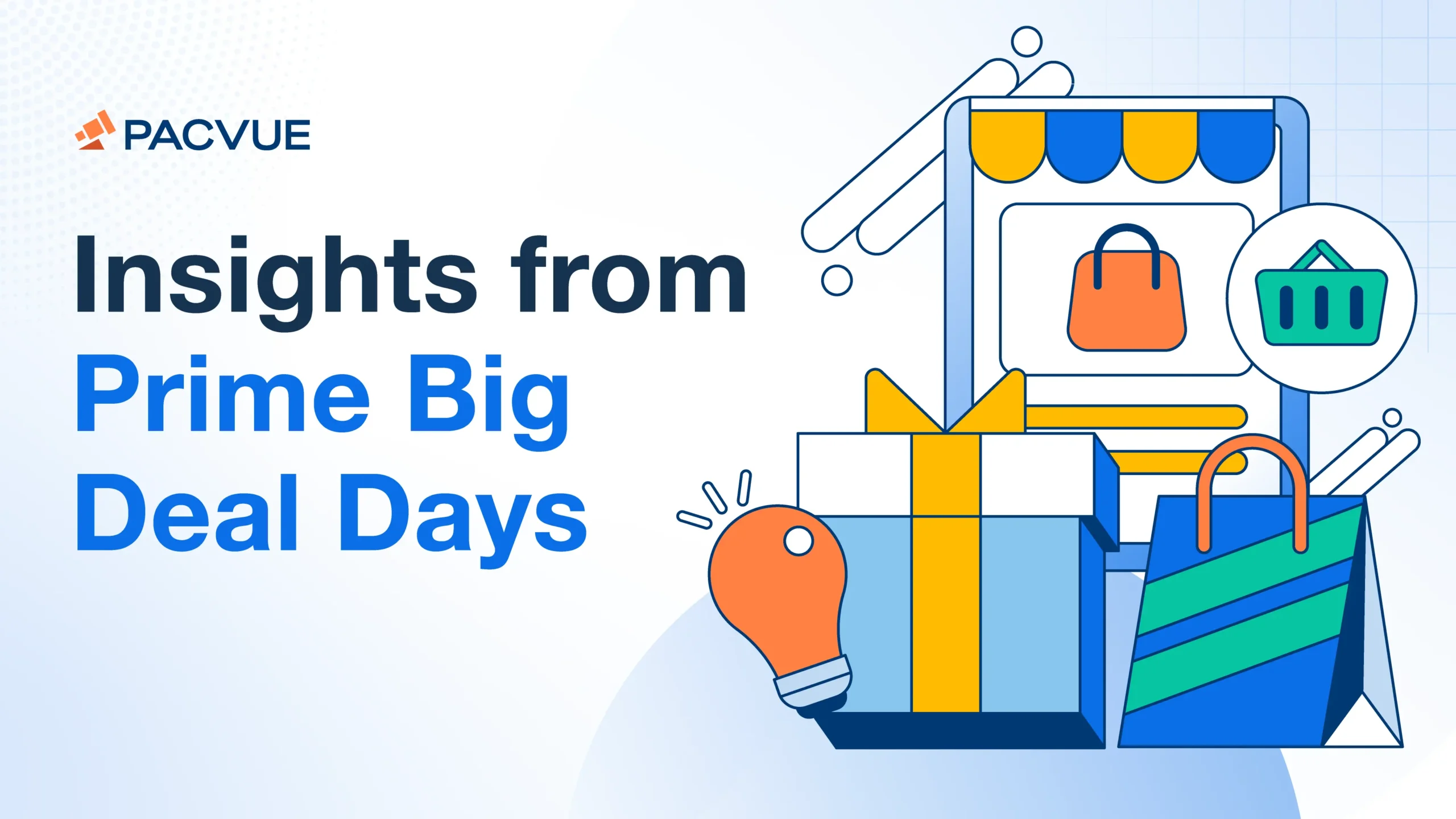With the holiday shopping season starting earlier and earlier, Amazon kicked off its two-day Prime Big Deal Days event for the second year in a row on October 10-11. Previously known as the Prime Early Access Sale in 2022, the second Amazon Prime sale of the year allowed Prime Members to start holiday shopping earlier this year by offering deep discounts on brands like Dyson, Sony, Barbie, SharkNinja, iRobot, LG, Peloton, Jabra and Betty Buzz by Blake Lively. Adding to the pre-holiday sales spree, Target held its Circle Week, and Walmart rolled out its Deals Holiday Kickoff event during the same period.
During these major shopping events, brands face higher levels of competition and go head-to-head for market share, making their advertising strategy a make-or-break factor in their overall sales revenue. So, what trends did we see?
About the report
Pacvue and Helium10 serve thousands of brands and agencies that sell on Amazon, so we took a deep dive into the Amazon sales event’s performance to break down the trends and key insights. To measure performance, we compared the seven days leading up to the event for week-over-week data, starting October 3, to the two days during which the sale event was running, on October 10-11. We also looked at a year-over-year comparison of this year’s sale event with the 2022 Prime Early Access Sale and the Prime Day event on July 11-12 earlier this year.
Increased Ad Spend
In terms of ad spend, Prime Big Deal Days saw advertisers invest more in the October event with a 35% increase in ad spend year-over-year between both ad types, but spend was down 41% compared to the July Prime Day event.
Both ad products increased ad spend significantly during the event, with Sponsored Products up 251% week-over-week on the first day of Prime Day and up 203% on the second day. Sponsored Products ad spend increased 37% year-over-year on the first day and 21% year-over-year on the second day of Prime Big Deal Days.
Sponsored Brands ad spend was up 301% week-over-week on the first day of Prime Big Deal Days and up 209% on the second day. Sponsored Brands ad spend increased 58% year-over-year on the first day and 25% year-over-year on the second day of Prime Big Deal Days.
With ad spend trending up year-over-year for tentpole shopping events, brands should plan to increase ad spend to similar or higher levels than the July Prime Day event. Brands should also consider improving product descriptions, A+ content, and high-quality product images to convert more customers.
To make your ads more efficient during Cyber 5, start preparing your campaign budgets now to be ready for any sharp increases in spend during the event. To prepare beforehand, use automation to set a budget template for Cyber 5 and apply it across all your campaigns. You can schedule budget increases ahead of time for a set number of days, with lead-in and lead-out, and reuse the same settings again. You can also use features like Pacvue’s Budget Auto-Refill to set parameters to automatically refill campaign budgets when they run out, but only if your campaign hits your preset performance goals.


Cost-per-click up YoY, down from July Prime Day
The cost-per-click for Sponsored Products saw a 42% increase week-over-week, reaching an average CPC of $1.79 on both days of Prime Big Deal Days. Looking at the past two Prime Day events, Sponsored Products saw a 4% increase year-over-year but a –19% decrease compared to the July 2023 Prime Day.
Sponsored Brands followed a similar trend. Cost-per-click increased 42% week-over-week on the first day, followed by a 25% increase on the second day, with an average CPC of $2.41. Year-over-year, CPC increased by 8% but was –11% lower compared to the July 2023 Prime Day.
Overall, CPC saw significant increases week-over-week and year-over-year for both ad types. Still, the average CPC remained considerably lower than the July Prime Day event, suggesting less competition during this event.
While it is impossible to predict if cost-per-click will be higher or lower than last year’s Cyber 5 event, the average CPC trended up over the past two Prime Day events. To stay competitive, set up rules for the lead-in, Cyber 5, and the lead-out, such as higher maximum CPC or expected impressions. You can also use Pacvue’s rules to automatically revert bids to pre-event levels once the event ends.


Decline in ROAS
Despite a significant year-over-year increase in ad spend, the Return on Ad Spend (ROAS) for Sponsored Products and Sponsored Brands took a hit during Prime Big Deal Days.
For Sponsored Products, ROAS decreased –10% year-over-year and were –7% lower than the July event, with the average ROAS of $4.99. For Sponsored Brands, ROAS decreased –5% year-over-year and were -23% lower than the July event, with the average ROAS of $4.98.
Even though brands invested more in the event than last year, the surge in ad spend did not translate into proportionate returns on ad spend. Advertisers should continue to refine their ad strategies to maintain efficiency amidst increasing competition and have a solid post-event strategy ready to launch after Cyber 5. Brands can leverage retargeting campaigns to encourage potential customers to buy from their brand even after the sale has ended and maximize ROAS.


Category Results
The Toys & Games category had some of the most significant shifts in performance out of all categories during the October Prime event. Ad spend increased the most out of all categories compared to last year, increasing 159%.
However, the cost-per-click also increased the most year-over-year, rising by 57.5% for an average CPC of $0.73 during the two-day event. While advertisers were willing to invest more into the event, there was a significant decrease in return on ad spend (ROAS), which dropped by 50.2% year-over-year. Overall, the Toys & Games category saw a 28.8% increase in sales this year.
Baby Products, on the other hand, saw nearly opposite performance results. Ad spend only increased a modest 15% year-over-year, one of the lowest increases out of all categories, but ROAS increased 74%, and sales saw an impressive 101% increase. The cost-per-click for Baby Products saw mixed results, decreasing -4.5% on day one but increased 24.5% on day two for an average CPC of $1.68.
Prepping for Cyber 5
Now that the holiday shopping season has started, here are a few tips to help brands using Pacvue optimize Amazon Ads campaigns in the lead-out from Q4 shopping events. Of course, there is no one-size-fits-all approach to the holiday season, but those with a solid strategy typically see success.
Contact us today to learn more about the Pacvue Platform and how our team can help scale your brand on Amazon and across dozens of retailers in Q4.















